Comparative Analysis: MAS Implementation in Manufacturing Companies
VerifiedAdded on 2022/10/13
|11
|3622
|16
Report
AI Summary
This report provides a comprehensive analysis of the impact of Management Accounting Systems (MAS) within multinational manufacturing companies, drawing insights from two distinct case studies. It begins by defining MAS and highlighting its critical role in planning, decision-making, and strategy development. The report then delves into a case study of a manufacturing company, detailing the implementation of various MAS techniques such as Activity-Based Costing (ABC), Just-In-Time (JIT), Total Quality Management (TQM), and Balanced Scorecard (BSC), and their effects on the organization. The analysis extends to the relevance of MAS across different management levels, from operational to strategic. The report further compares and contrasts this case study with another, focusing on Malaysian manufacturing companies, to demonstrate the adaptability and benefits of MAS in competitive environments, including improved productivity and cost reduction. The report concludes by emphasizing the critical role of MAS in achieving competitive advantages and organizational goals in today's dynamic business landscape.

Paraphrase This Document
Need a fresh take? Get an instant paraphrase of this document with our AI Paraphraser
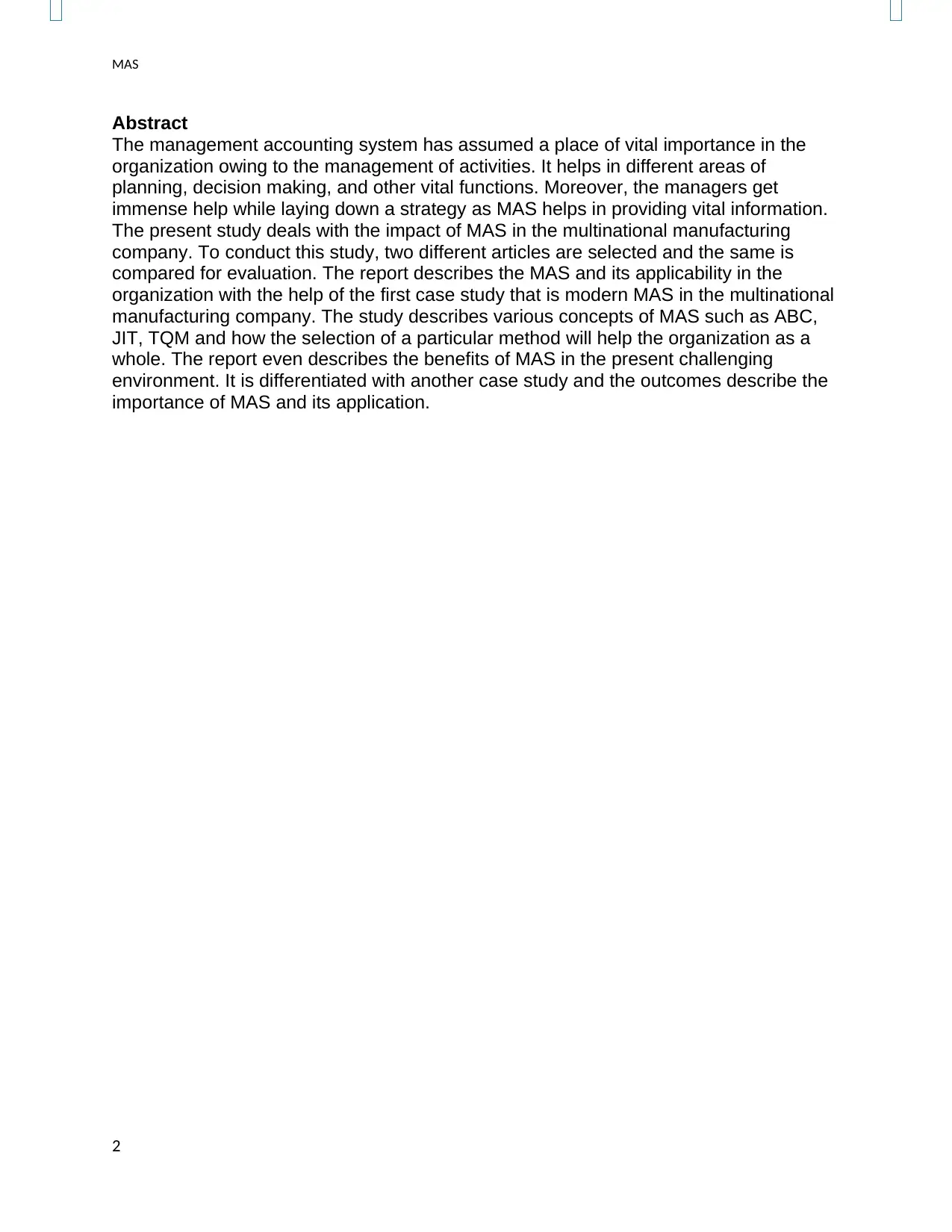
MAS
Abstract
The management accounting system has assumed a place of vital importance in the
organization owing to the management of activities. It helps in different areas of
planning, decision making, and other vital functions. Moreover, the managers get
immense help while laying down a strategy as MAS helps in providing vital information.
The present study deals with the impact of MAS in the multinational manufacturing
company. To conduct this study, two different articles are selected and the same is
compared for evaluation. The report describes the MAS and its applicability in the
organization with the help of the first case study that is modern MAS in the multinational
manufacturing company. The study describes various concepts of MAS such as ABC,
JIT, TQM and how the selection of a particular method will help the organization as a
whole. The report even describes the benefits of MAS in the present challenging
environment. It is differentiated with another case study and the outcomes describe the
importance of MAS and its application.
2
Abstract
The management accounting system has assumed a place of vital importance in the
organization owing to the management of activities. It helps in different areas of
planning, decision making, and other vital functions. Moreover, the managers get
immense help while laying down a strategy as MAS helps in providing vital information.
The present study deals with the impact of MAS in the multinational manufacturing
company. To conduct this study, two different articles are selected and the same is
compared for evaluation. The report describes the MAS and its applicability in the
organization with the help of the first case study that is modern MAS in the multinational
manufacturing company. The study describes various concepts of MAS such as ABC,
JIT, TQM and how the selection of a particular method will help the organization as a
whole. The report even describes the benefits of MAS in the present challenging
environment. It is differentiated with another case study and the outcomes describe the
importance of MAS and its application.
2
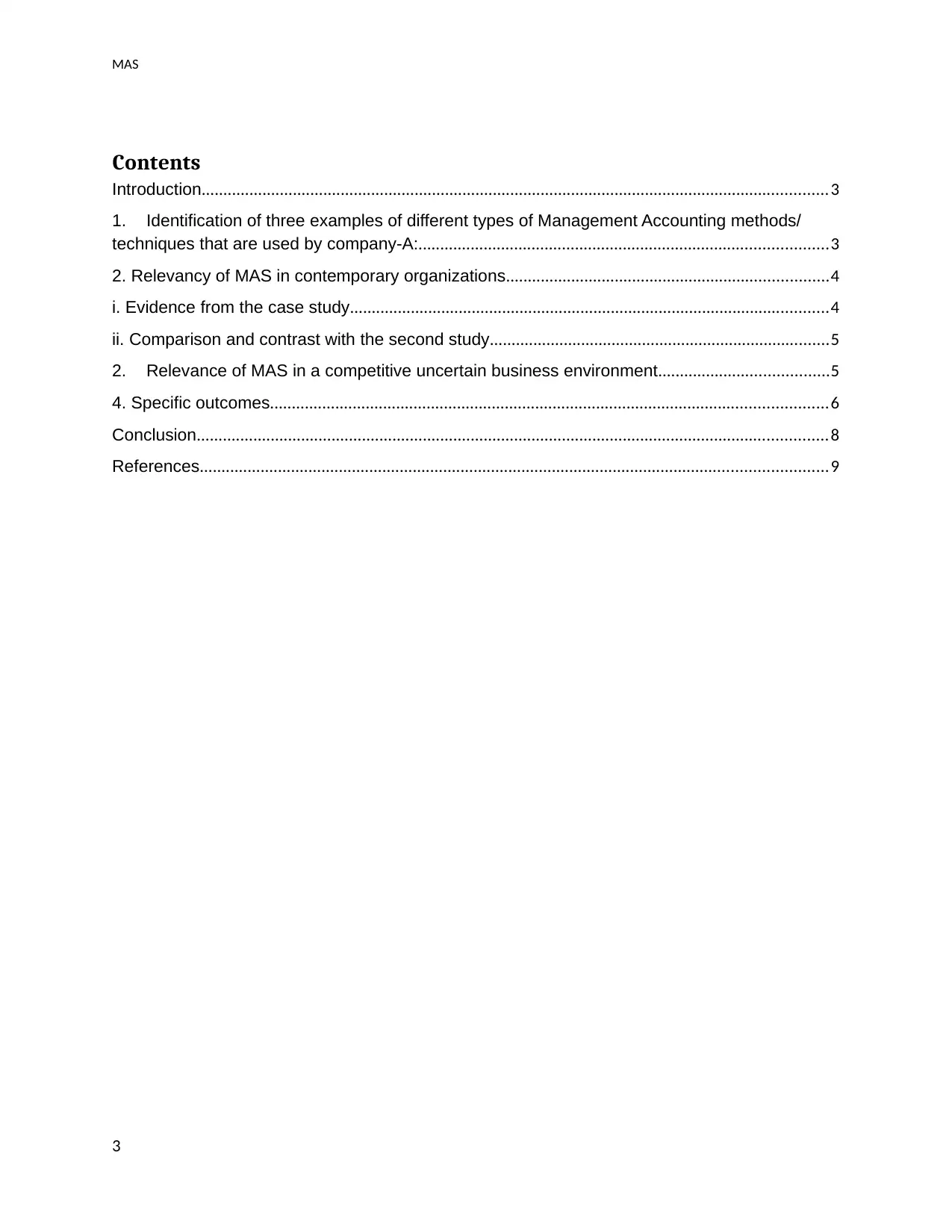
MAS
Contents
Introduction................................................................................................................................................3
1. Identification of three examples of different types of Management Accounting methods/
techniques that are used by company-A:..............................................................................................3
2. Relevancy of MAS in contemporary organizations..........................................................................4
i. Evidence from the case study..............................................................................................................4
ii. Comparison and contrast with the second study..............................................................................5
2. Relevance of MAS in a competitive uncertain business environment.......................................5
4. Specific outcomes................................................................................................................................6
Conclusion.................................................................................................................................................8
References................................................................................................................................................9
3
Contents
Introduction................................................................................................................................................3
1. Identification of three examples of different types of Management Accounting methods/
techniques that are used by company-A:..............................................................................................3
2. Relevancy of MAS in contemporary organizations..........................................................................4
i. Evidence from the case study..............................................................................................................4
ii. Comparison and contrast with the second study..............................................................................5
2. Relevance of MAS in a competitive uncertain business environment.......................................5
4. Specific outcomes................................................................................................................................6
Conclusion.................................................................................................................................................8
References................................................................................................................................................9
3
⊘ This is a preview!⊘
Do you want full access?
Subscribe today to unlock all pages.

Trusted by 1+ million students worldwide
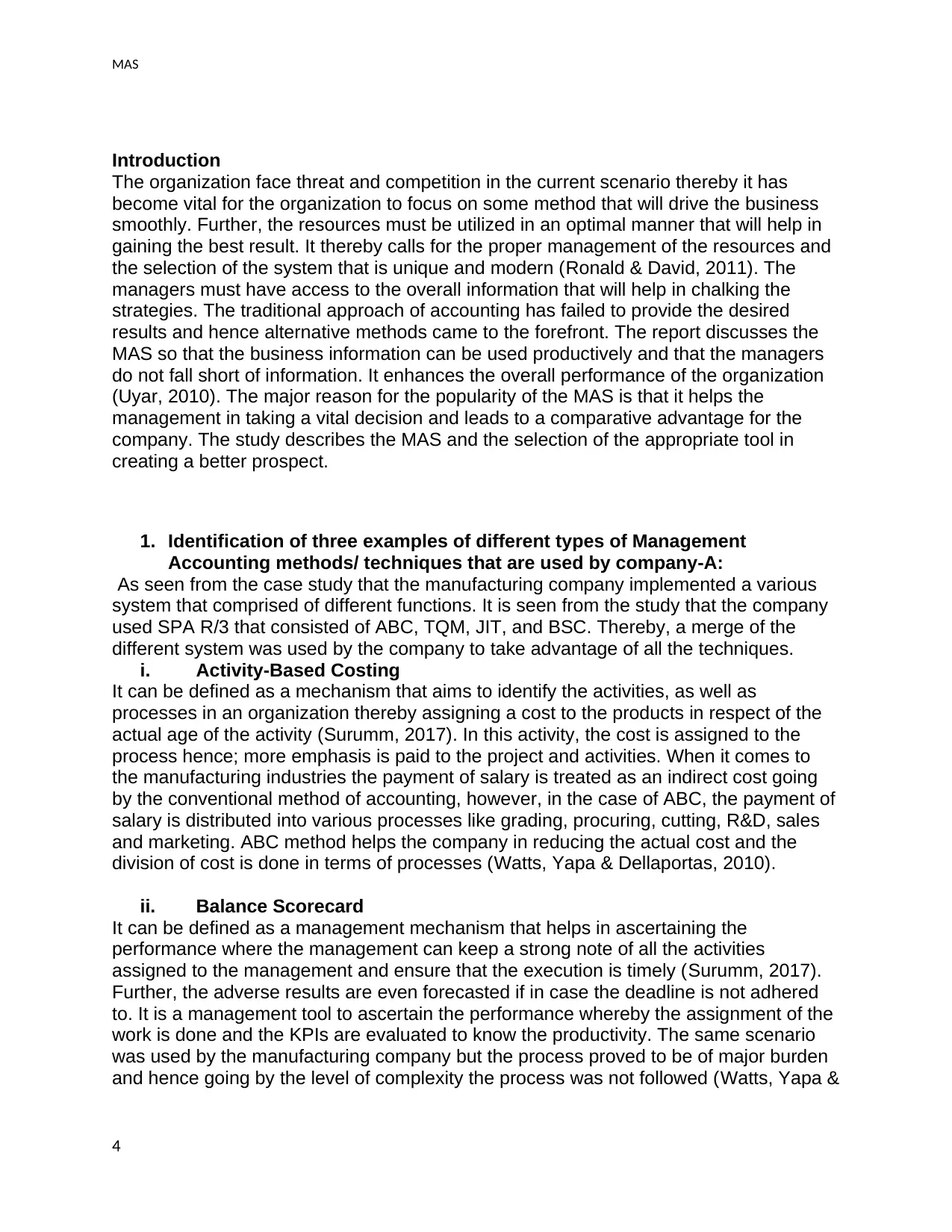
MAS
Introduction
The organization face threat and competition in the current scenario thereby it has
become vital for the organization to focus on some method that will drive the business
smoothly. Further, the resources must be utilized in an optimal manner that will help in
gaining the best result. It thereby calls for the proper management of the resources and
the selection of the system that is unique and modern (Ronald & David, 2011). The
managers must have access to the overall information that will help in chalking the
strategies. The traditional approach of accounting has failed to provide the desired
results and hence alternative methods came to the forefront. The report discusses the
MAS so that the business information can be used productively and that the managers
do not fall short of information. It enhances the overall performance of the organization
(Uyar, 2010). The major reason for the popularity of the MAS is that it helps the
management in taking a vital decision and leads to a comparative advantage for the
company. The study describes the MAS and the selection of the appropriate tool in
creating a better prospect.
1. Identification of three examples of different types of Management
Accounting methods/ techniques that are used by company-A:
As seen from the case study that the manufacturing company implemented a various
system that comprised of different functions. It is seen from the study that the company
used SPA R/3 that consisted of ABC, TQM, JIT, and BSC. Thereby, a merge of the
different system was used by the company to take advantage of all the techniques.
i. Activity-Based Costing
It can be defined as a mechanism that aims to identify the activities, as well as
processes in an organization thereby assigning a cost to the products in respect of the
actual age of the activity (Surumm, 2017). In this activity, the cost is assigned to the
process hence; more emphasis is paid to the project and activities. When it comes to
the manufacturing industries the payment of salary is treated as an indirect cost going
by the conventional method of accounting, however, in the case of ABC, the payment of
salary is distributed into various processes like grading, procuring, cutting, R&D, sales
and marketing. ABC method helps the company in reducing the actual cost and the
division of cost is done in terms of processes (Watts, Yapa & Dellaportas, 2010).
ii. Balance Scorecard
It can be defined as a management mechanism that helps in ascertaining the
performance where the management can keep a strong note of all the activities
assigned to the management and ensure that the execution is timely (Surumm, 2017).
Further, the adverse results are even forecasted if in case the deadline is not adhered
to. It is a management tool to ascertain the performance whereby the assignment of the
work is done and the KPIs are evaluated to know the productivity. The same scenario
was used by the manufacturing company but the process proved to be of major burden
and hence going by the level of complexity the process was not followed (Watts, Yapa &
4
Introduction
The organization face threat and competition in the current scenario thereby it has
become vital for the organization to focus on some method that will drive the business
smoothly. Further, the resources must be utilized in an optimal manner that will help in
gaining the best result. It thereby calls for the proper management of the resources and
the selection of the system that is unique and modern (Ronald & David, 2011). The
managers must have access to the overall information that will help in chalking the
strategies. The traditional approach of accounting has failed to provide the desired
results and hence alternative methods came to the forefront. The report discusses the
MAS so that the business information can be used productively and that the managers
do not fall short of information. It enhances the overall performance of the organization
(Uyar, 2010). The major reason for the popularity of the MAS is that it helps the
management in taking a vital decision and leads to a comparative advantage for the
company. The study describes the MAS and the selection of the appropriate tool in
creating a better prospect.
1. Identification of three examples of different types of Management
Accounting methods/ techniques that are used by company-A:
As seen from the case study that the manufacturing company implemented a various
system that comprised of different functions. It is seen from the study that the company
used SPA R/3 that consisted of ABC, TQM, JIT, and BSC. Thereby, a merge of the
different system was used by the company to take advantage of all the techniques.
i. Activity-Based Costing
It can be defined as a mechanism that aims to identify the activities, as well as
processes in an organization thereby assigning a cost to the products in respect of the
actual age of the activity (Surumm, 2017). In this activity, the cost is assigned to the
process hence; more emphasis is paid to the project and activities. When it comes to
the manufacturing industries the payment of salary is treated as an indirect cost going
by the conventional method of accounting, however, in the case of ABC, the payment of
salary is distributed into various processes like grading, procuring, cutting, R&D, sales
and marketing. ABC method helps the company in reducing the actual cost and the
division of cost is done in terms of processes (Watts, Yapa & Dellaportas, 2010).
ii. Balance Scorecard
It can be defined as a management mechanism that helps in ascertaining the
performance where the management can keep a strong note of all the activities
assigned to the management and ensure that the execution is timely (Surumm, 2017).
Further, the adverse results are even forecasted if in case the deadline is not adhered
to. It is a management tool to ascertain the performance whereby the assignment of the
work is done and the KPIs are evaluated to know the productivity. The same scenario
was used by the manufacturing company but the process proved to be of major burden
and hence going by the level of complexity the process was not followed (Watts, Yapa &
4
Paraphrase This Document
Need a fresh take? Get an instant paraphrase of this document with our AI Paraphraser
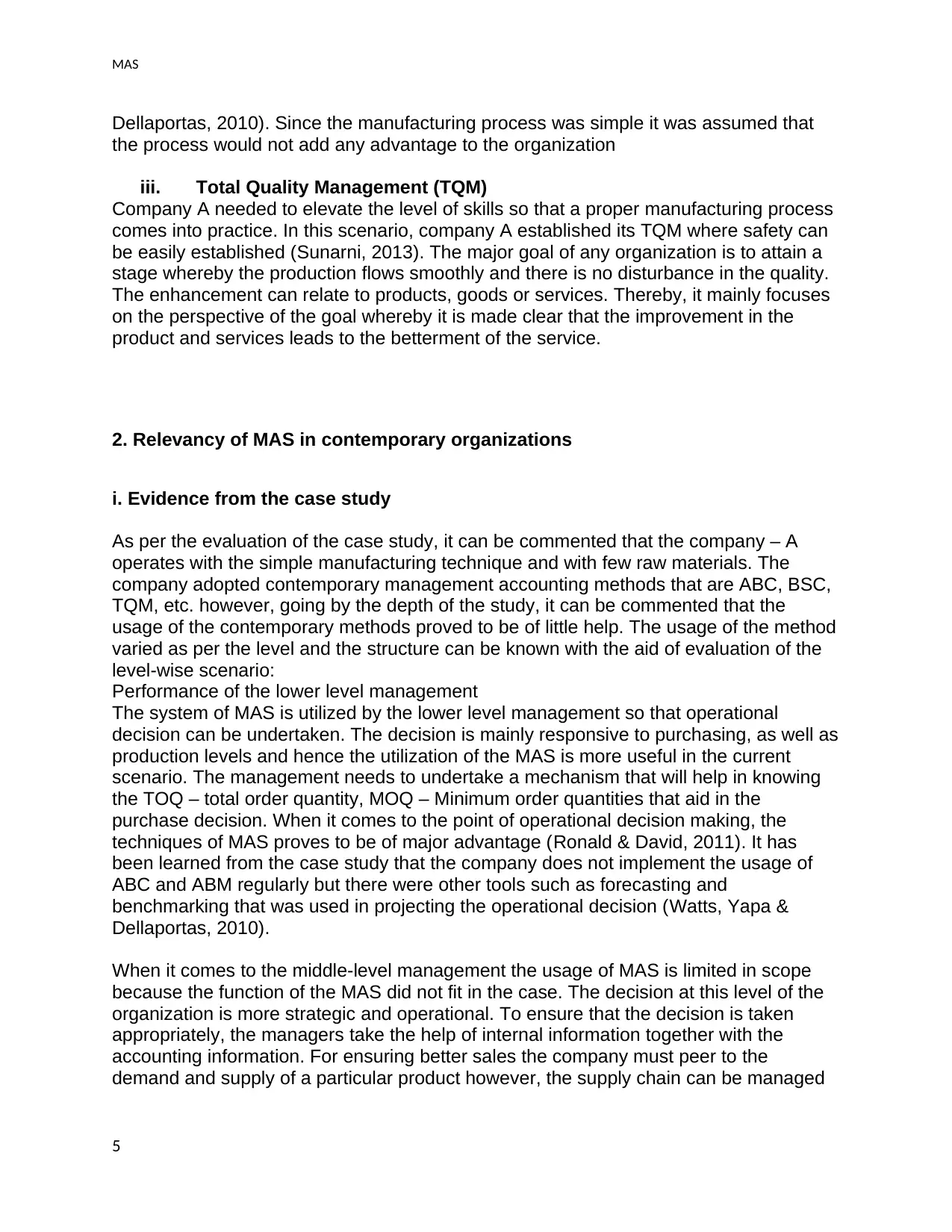
MAS
Dellaportas, 2010). Since the manufacturing process was simple it was assumed that
the process would not add any advantage to the organization
iii. Total Quality Management (TQM)
Company A needed to elevate the level of skills so that a proper manufacturing process
comes into practice. In this scenario, company A established its TQM where safety can
be easily established (Sunarni, 2013). The major goal of any organization is to attain a
stage whereby the production flows smoothly and there is no disturbance in the quality.
The enhancement can relate to products, goods or services. Thereby, it mainly focuses
on the perspective of the goal whereby it is made clear that the improvement in the
product and services leads to the betterment of the service.
2. Relevancy of MAS in contemporary organizations
i. Evidence from the case study
As per the evaluation of the case study, it can be commented that the company – A
operates with the simple manufacturing technique and with few raw materials. The
company adopted contemporary management accounting methods that are ABC, BSC,
TQM, etc. however, going by the depth of the study, it can be commented that the
usage of the contemporary methods proved to be of little help. The usage of the method
varied as per the level and the structure can be known with the aid of evaluation of the
level-wise scenario:
Performance of the lower level management
The system of MAS is utilized by the lower level management so that operational
decision can be undertaken. The decision is mainly responsive to purchasing, as well as
production levels and hence the utilization of the MAS is more useful in the current
scenario. The management needs to undertake a mechanism that will help in knowing
the TOQ – total order quantity, MOQ – Minimum order quantities that aid in the
purchase decision. When it comes to the point of operational decision making, the
techniques of MAS proves to be of major advantage (Ronald & David, 2011). It has
been learned from the case study that the company does not implement the usage of
ABC and ABM regularly but there were other tools such as forecasting and
benchmarking that was used in projecting the operational decision (Watts, Yapa &
Dellaportas, 2010).
When it comes to the middle-level management the usage of MAS is limited in scope
because the function of the MAS did not fit in the case. The decision at this level of the
organization is more strategic and operational. To ensure that the decision is taken
appropriately, the managers take the help of internal information together with the
accounting information. For ensuring better sales the company must peer to the
demand and supply of a particular product however, the supply chain can be managed
5
Dellaportas, 2010). Since the manufacturing process was simple it was assumed that
the process would not add any advantage to the organization
iii. Total Quality Management (TQM)
Company A needed to elevate the level of skills so that a proper manufacturing process
comes into practice. In this scenario, company A established its TQM where safety can
be easily established (Sunarni, 2013). The major goal of any organization is to attain a
stage whereby the production flows smoothly and there is no disturbance in the quality.
The enhancement can relate to products, goods or services. Thereby, it mainly focuses
on the perspective of the goal whereby it is made clear that the improvement in the
product and services leads to the betterment of the service.
2. Relevancy of MAS in contemporary organizations
i. Evidence from the case study
As per the evaluation of the case study, it can be commented that the company – A
operates with the simple manufacturing technique and with few raw materials. The
company adopted contemporary management accounting methods that are ABC, BSC,
TQM, etc. however, going by the depth of the study, it can be commented that the
usage of the contemporary methods proved to be of little help. The usage of the method
varied as per the level and the structure can be known with the aid of evaluation of the
level-wise scenario:
Performance of the lower level management
The system of MAS is utilized by the lower level management so that operational
decision can be undertaken. The decision is mainly responsive to purchasing, as well as
production levels and hence the utilization of the MAS is more useful in the current
scenario. The management needs to undertake a mechanism that will help in knowing
the TOQ – total order quantity, MOQ – Minimum order quantities that aid in the
purchase decision. When it comes to the point of operational decision making, the
techniques of MAS proves to be of major advantage (Ronald & David, 2011). It has
been learned from the case study that the company does not implement the usage of
ABC and ABM regularly but there were other tools such as forecasting and
benchmarking that was used in projecting the operational decision (Watts, Yapa &
Dellaportas, 2010).
When it comes to the middle-level management the usage of MAS is limited in scope
because the function of the MAS did not fit in the case. The decision at this level of the
organization is more strategic and operational. To ensure that the decision is taken
appropriately, the managers take the help of internal information together with the
accounting information. For ensuring better sales the company must peer to the
demand and supply of a particular product however, the supply chain can be managed
5
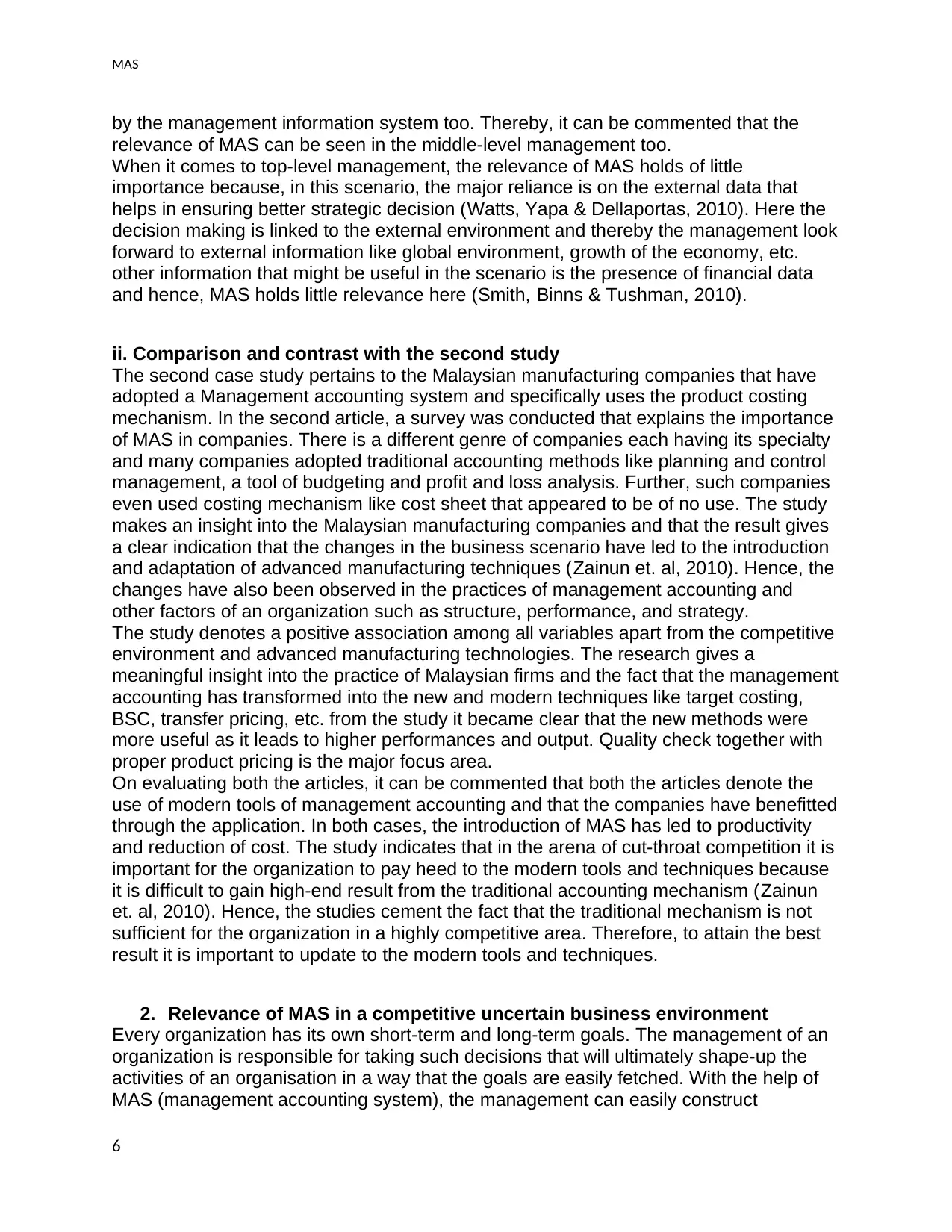
MAS
by the management information system too. Thereby, it can be commented that the
relevance of MAS can be seen in the middle-level management too.
When it comes to top-level management, the relevance of MAS holds of little
importance because, in this scenario, the major reliance is on the external data that
helps in ensuring better strategic decision (Watts, Yapa & Dellaportas, 2010). Here the
decision making is linked to the external environment and thereby the management look
forward to external information like global environment, growth of the economy, etc.
other information that might be useful in the scenario is the presence of financial data
and hence, MAS holds little relevance here (Smith, Binns & Tushman, 2010).
ii. Comparison and contrast with the second study
The second case study pertains to the Malaysian manufacturing companies that have
adopted a Management accounting system and specifically uses the product costing
mechanism. In the second article, a survey was conducted that explains the importance
of MAS in companies. There is a different genre of companies each having its specialty
and many companies adopted traditional accounting methods like planning and control
management, a tool of budgeting and profit and loss analysis. Further, such companies
even used costing mechanism like cost sheet that appeared to be of no use. The study
makes an insight into the Malaysian manufacturing companies and that the result gives
a clear indication that the changes in the business scenario have led to the introduction
and adaptation of advanced manufacturing techniques (Zainun et. al, 2010). Hence, the
changes have also been observed in the practices of management accounting and
other factors of an organization such as structure, performance, and strategy.
The study denotes a positive association among all variables apart from the competitive
environment and advanced manufacturing technologies. The research gives a
meaningful insight into the practice of Malaysian firms and the fact that the management
accounting has transformed into the new and modern techniques like target costing,
BSC, transfer pricing, etc. from the study it became clear that the new methods were
more useful as it leads to higher performances and output. Quality check together with
proper product pricing is the major focus area.
On evaluating both the articles, it can be commented that both the articles denote the
use of modern tools of management accounting and that the companies have benefitted
through the application. In both cases, the introduction of MAS has led to productivity
and reduction of cost. The study indicates that in the arena of cut-throat competition it is
important for the organization to pay heed to the modern tools and techniques because
it is difficult to gain high-end result from the traditional accounting mechanism (Zainun
et. al, 2010). Hence, the studies cement the fact that the traditional mechanism is not
sufficient for the organization in a highly competitive area. Therefore, to attain the best
result it is important to update to the modern tools and techniques.
2. Relevance of MAS in a competitive uncertain business environment
Every organization has its own short-term and long-term goals. The management of an
organization is responsible for taking such decisions that will ultimately shape-up the
activities of an organisation in a way that the goals are easily fetched. With the help of
MAS (management accounting system), the management can easily construct
6
by the management information system too. Thereby, it can be commented that the
relevance of MAS can be seen in the middle-level management too.
When it comes to top-level management, the relevance of MAS holds of little
importance because, in this scenario, the major reliance is on the external data that
helps in ensuring better strategic decision (Watts, Yapa & Dellaportas, 2010). Here the
decision making is linked to the external environment and thereby the management look
forward to external information like global environment, growth of the economy, etc.
other information that might be useful in the scenario is the presence of financial data
and hence, MAS holds little relevance here (Smith, Binns & Tushman, 2010).
ii. Comparison and contrast with the second study
The second case study pertains to the Malaysian manufacturing companies that have
adopted a Management accounting system and specifically uses the product costing
mechanism. In the second article, a survey was conducted that explains the importance
of MAS in companies. There is a different genre of companies each having its specialty
and many companies adopted traditional accounting methods like planning and control
management, a tool of budgeting and profit and loss analysis. Further, such companies
even used costing mechanism like cost sheet that appeared to be of no use. The study
makes an insight into the Malaysian manufacturing companies and that the result gives
a clear indication that the changes in the business scenario have led to the introduction
and adaptation of advanced manufacturing techniques (Zainun et. al, 2010). Hence, the
changes have also been observed in the practices of management accounting and
other factors of an organization such as structure, performance, and strategy.
The study denotes a positive association among all variables apart from the competitive
environment and advanced manufacturing technologies. The research gives a
meaningful insight into the practice of Malaysian firms and the fact that the management
accounting has transformed into the new and modern techniques like target costing,
BSC, transfer pricing, etc. from the study it became clear that the new methods were
more useful as it leads to higher performances and output. Quality check together with
proper product pricing is the major focus area.
On evaluating both the articles, it can be commented that both the articles denote the
use of modern tools of management accounting and that the companies have benefitted
through the application. In both cases, the introduction of MAS has led to productivity
and reduction of cost. The study indicates that in the arena of cut-throat competition it is
important for the organization to pay heed to the modern tools and techniques because
it is difficult to gain high-end result from the traditional accounting mechanism (Zainun
et. al, 2010). Hence, the studies cement the fact that the traditional mechanism is not
sufficient for the organization in a highly competitive area. Therefore, to attain the best
result it is important to update to the modern tools and techniques.
2. Relevance of MAS in a competitive uncertain business environment
Every organization has its own short-term and long-term goals. The management of an
organization is responsible for taking such decisions that will ultimately shape-up the
activities of an organisation in a way that the goals are easily fetched. With the help of
MAS (management accounting system), the management can easily construct
6
⊘ This is a preview!⊘
Do you want full access?
Subscribe today to unlock all pages.

Trusted by 1+ million students worldwide
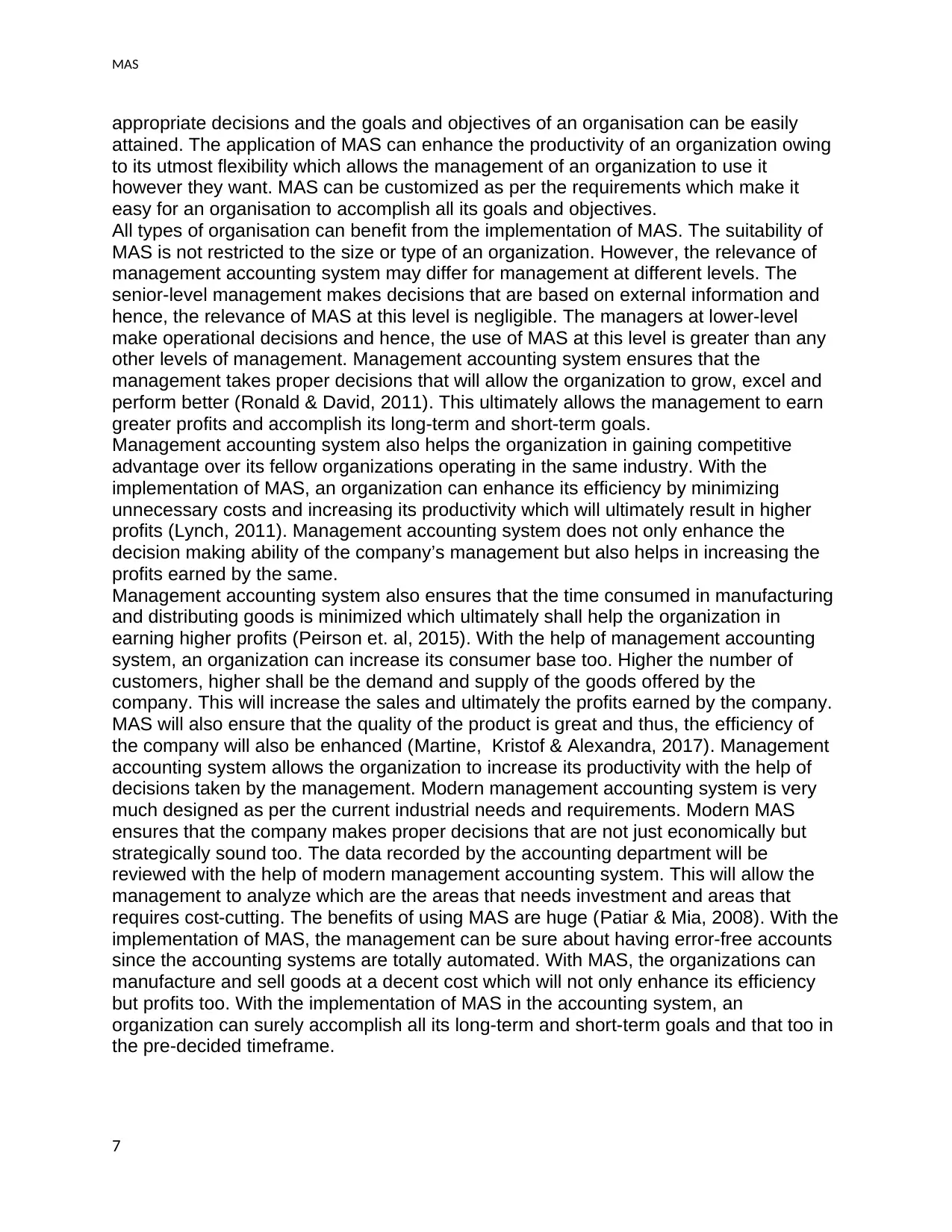
MAS
appropriate decisions and the goals and objectives of an organisation can be easily
attained. The application of MAS can enhance the productivity of an organization owing
to its utmost flexibility which allows the management of an organization to use it
however they want. MAS can be customized as per the requirements which make it
easy for an organisation to accomplish all its goals and objectives.
All types of organisation can benefit from the implementation of MAS. The suitability of
MAS is not restricted to the size or type of an organization. However, the relevance of
management accounting system may differ for management at different levels. The
senior-level management makes decisions that are based on external information and
hence, the relevance of MAS at this level is negligible. The managers at lower-level
make operational decisions and hence, the use of MAS at this level is greater than any
other levels of management. Management accounting system ensures that the
management takes proper decisions that will allow the organization to grow, excel and
perform better (Ronald & David, 2011). This ultimately allows the management to earn
greater profits and accomplish its long-term and short-term goals.
Management accounting system also helps the organization in gaining competitive
advantage over its fellow organizations operating in the same industry. With the
implementation of MAS, an organization can enhance its efficiency by minimizing
unnecessary costs and increasing its productivity which will ultimately result in higher
profits (Lynch, 2011). Management accounting system does not only enhance the
decision making ability of the company’s management but also helps in increasing the
profits earned by the same.
Management accounting system also ensures that the time consumed in manufacturing
and distributing goods is minimized which ultimately shall help the organization in
earning higher profits (Peirson et. al, 2015). With the help of management accounting
system, an organization can increase its consumer base too. Higher the number of
customers, higher shall be the demand and supply of the goods offered by the
company. This will increase the sales and ultimately the profits earned by the company.
MAS will also ensure that the quality of the product is great and thus, the efficiency of
the company will also be enhanced (Martine, Kristof & Alexandra, 2017). Management
accounting system allows the organization to increase its productivity with the help of
decisions taken by the management. Modern management accounting system is very
much designed as per the current industrial needs and requirements. Modern MAS
ensures that the company makes proper decisions that are not just economically but
strategically sound too. The data recorded by the accounting department will be
reviewed with the help of modern management accounting system. This will allow the
management to analyze which are the areas that needs investment and areas that
requires cost-cutting. The benefits of using MAS are huge (Patiar & Mia, 2008). With the
implementation of MAS, the management can be sure about having error-free accounts
since the accounting systems are totally automated. With MAS, the organizations can
manufacture and sell goods at a decent cost which will not only enhance its efficiency
but profits too. With the implementation of MAS in the accounting system, an
organization can surely accomplish all its long-term and short-term goals and that too in
the pre-decided timeframe.
7
appropriate decisions and the goals and objectives of an organisation can be easily
attained. The application of MAS can enhance the productivity of an organization owing
to its utmost flexibility which allows the management of an organization to use it
however they want. MAS can be customized as per the requirements which make it
easy for an organisation to accomplish all its goals and objectives.
All types of organisation can benefit from the implementation of MAS. The suitability of
MAS is not restricted to the size or type of an organization. However, the relevance of
management accounting system may differ for management at different levels. The
senior-level management makes decisions that are based on external information and
hence, the relevance of MAS at this level is negligible. The managers at lower-level
make operational decisions and hence, the use of MAS at this level is greater than any
other levels of management. Management accounting system ensures that the
management takes proper decisions that will allow the organization to grow, excel and
perform better (Ronald & David, 2011). This ultimately allows the management to earn
greater profits and accomplish its long-term and short-term goals.
Management accounting system also helps the organization in gaining competitive
advantage over its fellow organizations operating in the same industry. With the
implementation of MAS, an organization can enhance its efficiency by minimizing
unnecessary costs and increasing its productivity which will ultimately result in higher
profits (Lynch, 2011). Management accounting system does not only enhance the
decision making ability of the company’s management but also helps in increasing the
profits earned by the same.
Management accounting system also ensures that the time consumed in manufacturing
and distributing goods is minimized which ultimately shall help the organization in
earning higher profits (Peirson et. al, 2015). With the help of management accounting
system, an organization can increase its consumer base too. Higher the number of
customers, higher shall be the demand and supply of the goods offered by the
company. This will increase the sales and ultimately the profits earned by the company.
MAS will also ensure that the quality of the product is great and thus, the efficiency of
the company will also be enhanced (Martine, Kristof & Alexandra, 2017). Management
accounting system allows the organization to increase its productivity with the help of
decisions taken by the management. Modern management accounting system is very
much designed as per the current industrial needs and requirements. Modern MAS
ensures that the company makes proper decisions that are not just economically but
strategically sound too. The data recorded by the accounting department will be
reviewed with the help of modern management accounting system. This will allow the
management to analyze which are the areas that needs investment and areas that
requires cost-cutting. The benefits of using MAS are huge (Patiar & Mia, 2008). With the
implementation of MAS, the management can be sure about having error-free accounts
since the accounting systems are totally automated. With MAS, the organizations can
manufacture and sell goods at a decent cost which will not only enhance its efficiency
but profits too. With the implementation of MAS in the accounting system, an
organization can surely accomplish all its long-term and short-term goals and that too in
the pre-decided timeframe.
7
Paraphrase This Document
Need a fresh take? Get an instant paraphrase of this document with our AI Paraphraser
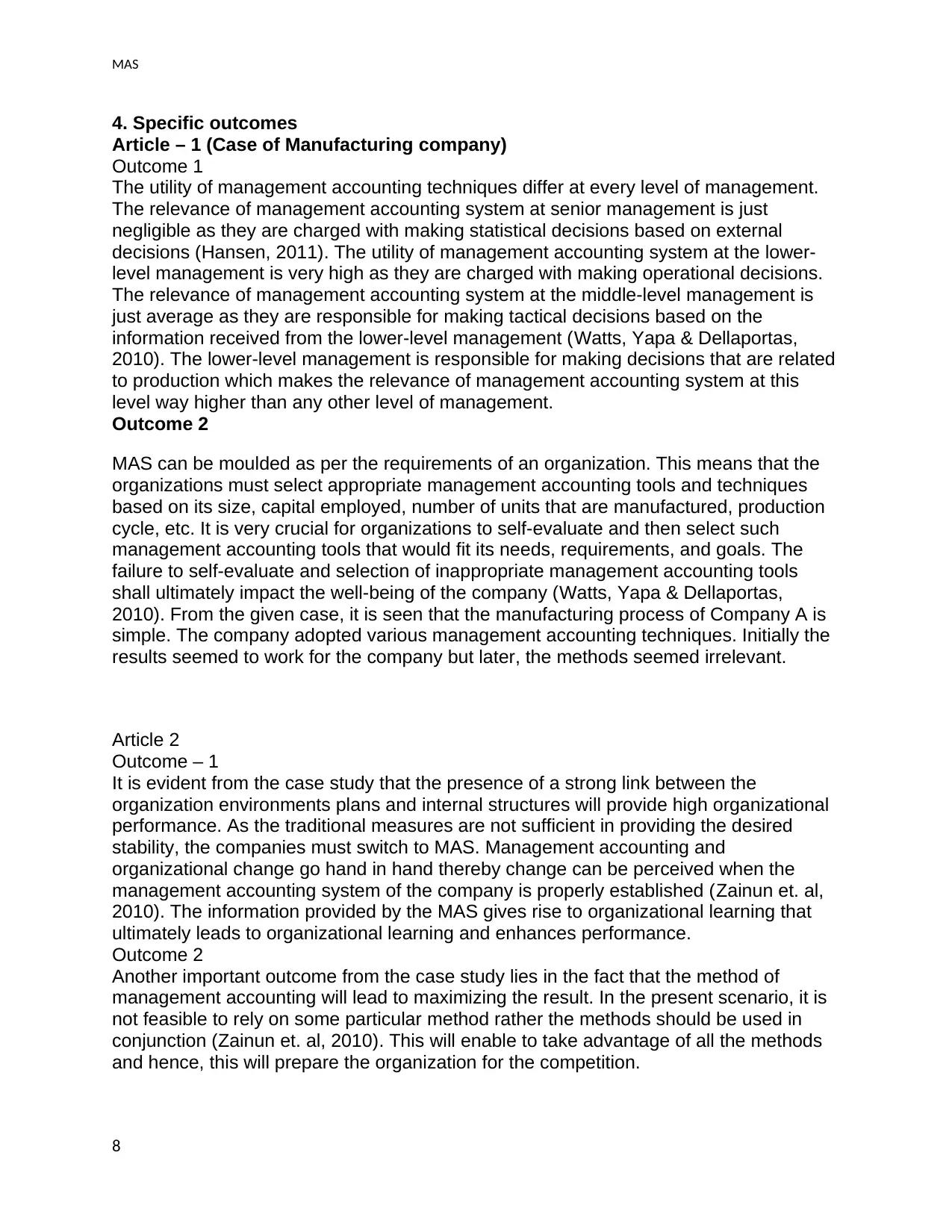
MAS
4. Specific outcomes
Article – 1 (Case of Manufacturing company)
Outcome 1
The utility of management accounting techniques differ at every level of management.
The relevance of management accounting system at senior management is just
negligible as they are charged with making statistical decisions based on external
decisions (Hansen, 2011). The utility of management accounting system at the lower-
level management is very high as they are charged with making operational decisions.
The relevance of management accounting system at the middle-level management is
just average as they are responsible for making tactical decisions based on the
information received from the lower-level management (Watts, Yapa & Dellaportas,
2010). The lower-level management is responsible for making decisions that are related
to production which makes the relevance of management accounting system at this
level way higher than any other level of management.
Outcome 2
MAS can be moulded as per the requirements of an organization. This means that the
organizations must select appropriate management accounting tools and techniques
based on its size, capital employed, number of units that are manufactured, production
cycle, etc. It is very crucial for organizations to self-evaluate and then select such
management accounting tools that would fit its needs, requirements, and goals. The
failure to self-evaluate and selection of inappropriate management accounting tools
shall ultimately impact the well-being of the company (Watts, Yapa & Dellaportas,
2010). From the given case, it is seen that the manufacturing process of Company A is
simple. The company adopted various management accounting techniques. Initially the
results seemed to work for the company but later, the methods seemed irrelevant.
Article 2
Outcome – 1
It is evident from the case study that the presence of a strong link between the
organization environments plans and internal structures will provide high organizational
performance. As the traditional measures are not sufficient in providing the desired
stability, the companies must switch to MAS. Management accounting and
organizational change go hand in hand thereby change can be perceived when the
management accounting system of the company is properly established (Zainun et. al,
2010). The information provided by the MAS gives rise to organizational learning that
ultimately leads to organizational learning and enhances performance.
Outcome 2
Another important outcome from the case study lies in the fact that the method of
management accounting will lead to maximizing the result. In the present scenario, it is
not feasible to rely on some particular method rather the methods should be used in
conjunction (Zainun et. al, 2010). This will enable to take advantage of all the methods
and hence, this will prepare the organization for the competition.
8
4. Specific outcomes
Article – 1 (Case of Manufacturing company)
Outcome 1
The utility of management accounting techniques differ at every level of management.
The relevance of management accounting system at senior management is just
negligible as they are charged with making statistical decisions based on external
decisions (Hansen, 2011). The utility of management accounting system at the lower-
level management is very high as they are charged with making operational decisions.
The relevance of management accounting system at the middle-level management is
just average as they are responsible for making tactical decisions based on the
information received from the lower-level management (Watts, Yapa & Dellaportas,
2010). The lower-level management is responsible for making decisions that are related
to production which makes the relevance of management accounting system at this
level way higher than any other level of management.
Outcome 2
MAS can be moulded as per the requirements of an organization. This means that the
organizations must select appropriate management accounting tools and techniques
based on its size, capital employed, number of units that are manufactured, production
cycle, etc. It is very crucial for organizations to self-evaluate and then select such
management accounting tools that would fit its needs, requirements, and goals. The
failure to self-evaluate and selection of inappropriate management accounting tools
shall ultimately impact the well-being of the company (Watts, Yapa & Dellaportas,
2010). From the given case, it is seen that the manufacturing process of Company A is
simple. The company adopted various management accounting techniques. Initially the
results seemed to work for the company but later, the methods seemed irrelevant.
Article 2
Outcome – 1
It is evident from the case study that the presence of a strong link between the
organization environments plans and internal structures will provide high organizational
performance. As the traditional measures are not sufficient in providing the desired
stability, the companies must switch to MAS. Management accounting and
organizational change go hand in hand thereby change can be perceived when the
management accounting system of the company is properly established (Zainun et. al,
2010). The information provided by the MAS gives rise to organizational learning that
ultimately leads to organizational learning and enhances performance.
Outcome 2
Another important outcome from the case study lies in the fact that the method of
management accounting will lead to maximizing the result. In the present scenario, it is
not feasible to rely on some particular method rather the methods should be used in
conjunction (Zainun et. al, 2010). This will enable to take advantage of all the methods
and hence, this will prepare the organization for the competition.
8
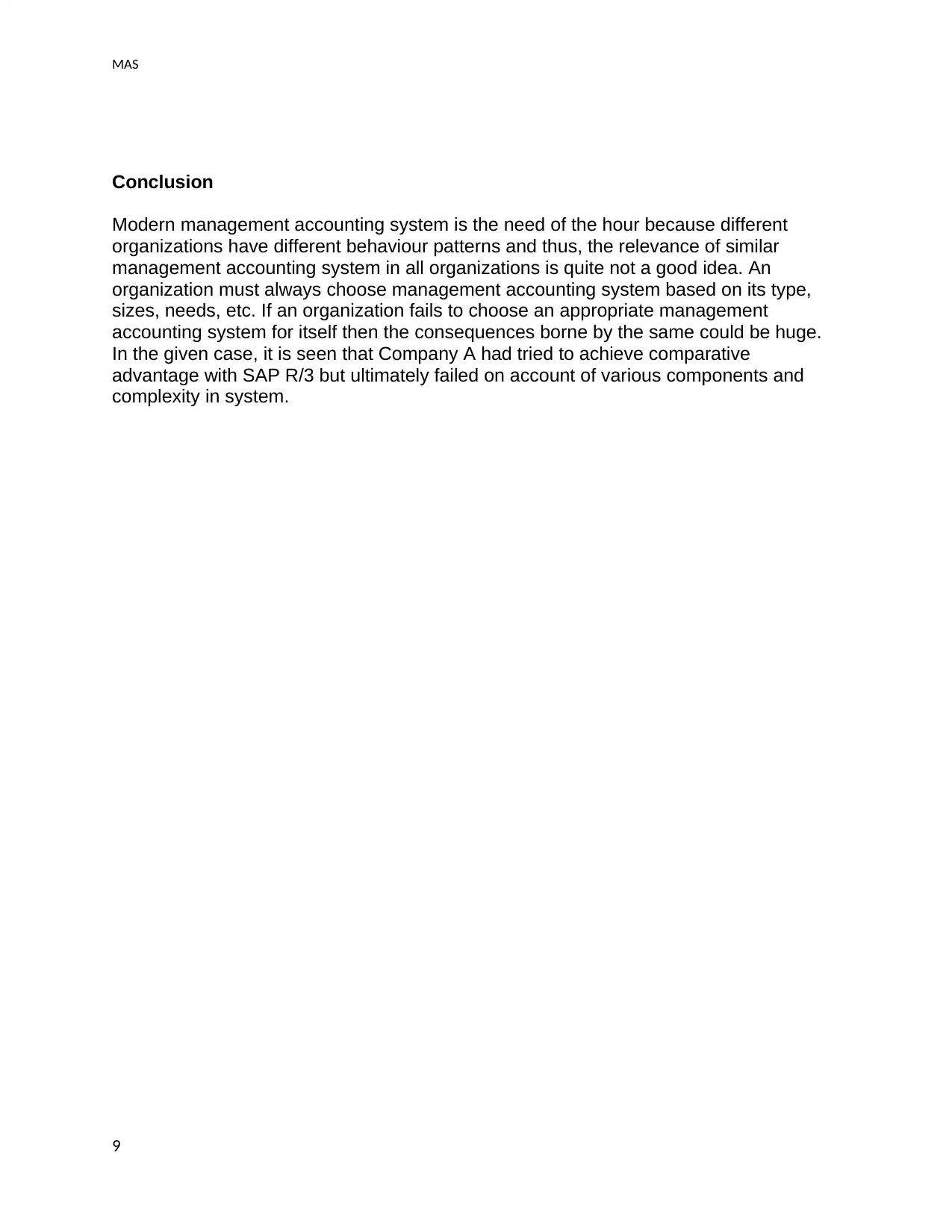
MAS
Conclusion
Modern management accounting system is the need of the hour because different
organizations have different behaviour patterns and thus, the relevance of similar
management accounting system in all organizations is quite not a good idea. An
organization must always choose management accounting system based on its type,
sizes, needs, etc. If an organization fails to choose an appropriate management
accounting system for itself then the consequences borne by the same could be huge.
In the given case, it is seen that Company A had tried to achieve comparative
advantage with SAP R/3 but ultimately failed on account of various components and
complexity in system.
9
Conclusion
Modern management accounting system is the need of the hour because different
organizations have different behaviour patterns and thus, the relevance of similar
management accounting system in all organizations is quite not a good idea. An
organization must always choose management accounting system based on its type,
sizes, needs, etc. If an organization fails to choose an appropriate management
accounting system for itself then the consequences borne by the same could be huge.
In the given case, it is seen that Company A had tried to achieve comparative
advantage with SAP R/3 but ultimately failed on account of various components and
complexity in system.
9
⊘ This is a preview!⊘
Do you want full access?
Subscribe today to unlock all pages.

Trusted by 1+ million students worldwide
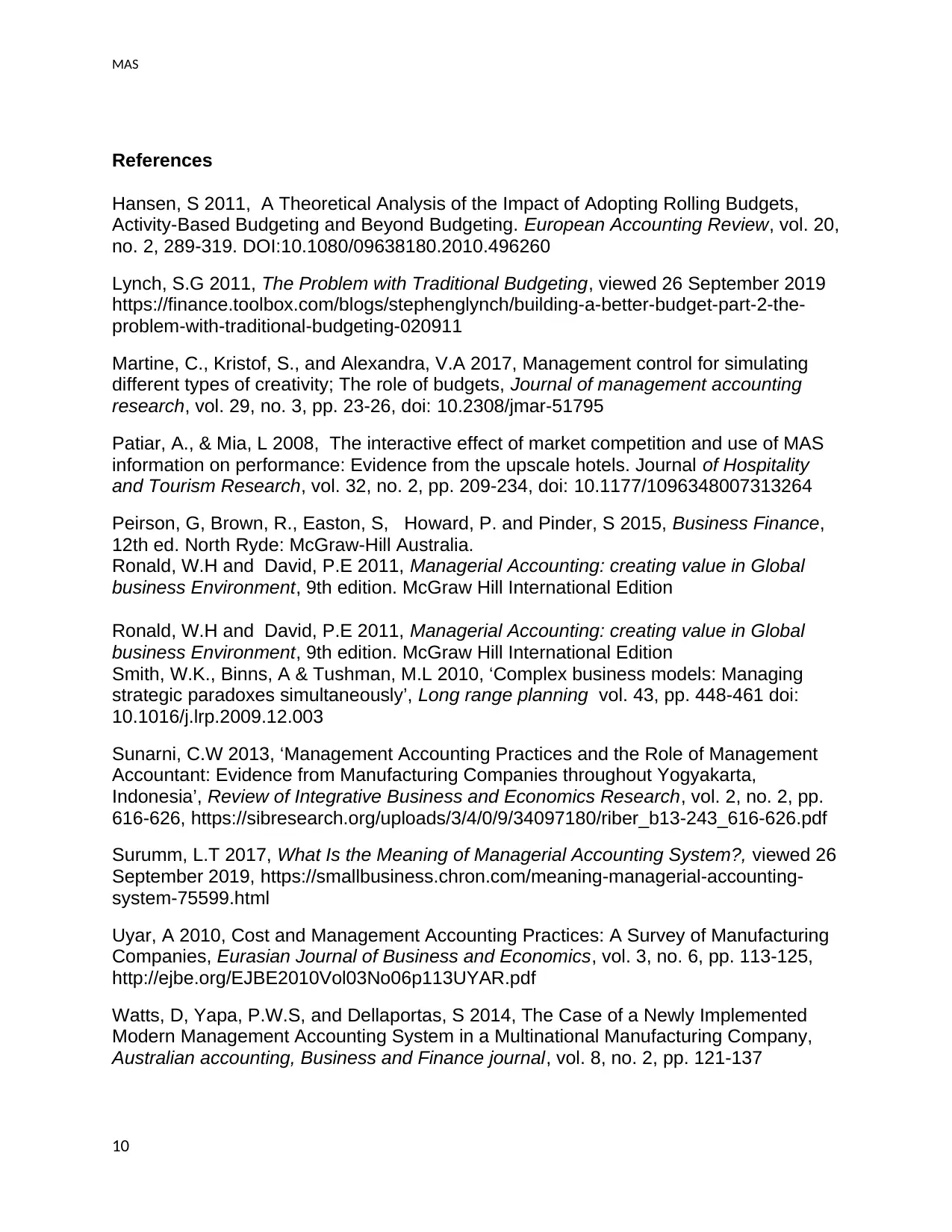
MAS
References
Hansen, S 2011, A Theoretical Analysis of the Impact of Adopting Rolling Budgets,
Activity-Based Budgeting and Beyond Budgeting. European Accounting Review, vol. 20,
no. 2, 289-319. DOI:10.1080/09638180.2010.496260
Lynch, S.G 2011, The Problem with Traditional Budgeting, viewed 26 September 2019
https://finance.toolbox.com/blogs/stephenglynch/building-a-better-budget-part-2-the-
problem-with-traditional-budgeting-020911
Martine, C., Kristof, S., and Alexandra, V.A 2017, Management control for simulating
different types of creativity; The role of budgets, Journal of management accounting
research, vol. 29, no. 3, pp. 23-26, doi: 10.2308/jmar-51795
Patiar, A., & Mia, L 2008, The interactive effect of market competition and use of MAS
information on performance: Evidence from the upscale hotels. Journal of Hospitality
and Tourism Research, vol. 32, no. 2, pp. 209-234, doi: 10.1177/1096348007313264
Peirson, G, Brown, R., Easton, S, Howard, P. and Pinder, S 2015, Business Finance,
12th ed. North Ryde: McGraw-Hill Australia.
Ronald, W.H and David, P.E 2011, Managerial Accounting: creating value in Global
business Environment, 9th edition. McGraw Hill International Edition
Ronald, W.H and David, P.E 2011, Managerial Accounting: creating value in Global
business Environment, 9th edition. McGraw Hill International Edition
Smith, W.K., Binns, A & Tushman, M.L 2010, ‘Complex business models: Managing
strategic paradoxes simultaneously’, Long range planning vol. 43, pp. 448-461 doi:
10.1016/j.lrp.2009.12.003
Sunarni, C.W 2013, ‘Management Accounting Practices and the Role of Management
Accountant: Evidence from Manufacturing Companies throughout Yogyakarta,
Indonesia’, Review of Integrative Business and Economics Research, vol. 2, no. 2, pp.
616-626, https://sibresearch.org/uploads/3/4/0/9/34097180/riber_b13-243_616-626.pdf
Surumm, L.T 2017, What Is the Meaning of Managerial Accounting System?, viewed 26
September 2019, https://smallbusiness.chron.com/meaning-managerial-accounting-
system-75599.html
Uyar, A 2010, Cost and Management Accounting Practices: A Survey of Manufacturing
Companies, Eurasian Journal of Business and Economics, vol. 3, no. 6, pp. 113-125,
http://ejbe.org/EJBE2010Vol03No06p113UYAR.pdf
Watts, D, Yapa, P.W.S, and Dellaportas, S 2014, The Case of a Newly Implemented
Modern Management Accounting System in a Multinational Manufacturing Company,
Australian accounting, Business and Finance journal, vol. 8, no. 2, pp. 121-137
10
References
Hansen, S 2011, A Theoretical Analysis of the Impact of Adopting Rolling Budgets,
Activity-Based Budgeting and Beyond Budgeting. European Accounting Review, vol. 20,
no. 2, 289-319. DOI:10.1080/09638180.2010.496260
Lynch, S.G 2011, The Problem with Traditional Budgeting, viewed 26 September 2019
https://finance.toolbox.com/blogs/stephenglynch/building-a-better-budget-part-2-the-
problem-with-traditional-budgeting-020911
Martine, C., Kristof, S., and Alexandra, V.A 2017, Management control for simulating
different types of creativity; The role of budgets, Journal of management accounting
research, vol. 29, no. 3, pp. 23-26, doi: 10.2308/jmar-51795
Patiar, A., & Mia, L 2008, The interactive effect of market competition and use of MAS
information on performance: Evidence from the upscale hotels. Journal of Hospitality
and Tourism Research, vol. 32, no. 2, pp. 209-234, doi: 10.1177/1096348007313264
Peirson, G, Brown, R., Easton, S, Howard, P. and Pinder, S 2015, Business Finance,
12th ed. North Ryde: McGraw-Hill Australia.
Ronald, W.H and David, P.E 2011, Managerial Accounting: creating value in Global
business Environment, 9th edition. McGraw Hill International Edition
Ronald, W.H and David, P.E 2011, Managerial Accounting: creating value in Global
business Environment, 9th edition. McGraw Hill International Edition
Smith, W.K., Binns, A & Tushman, M.L 2010, ‘Complex business models: Managing
strategic paradoxes simultaneously’, Long range planning vol. 43, pp. 448-461 doi:
10.1016/j.lrp.2009.12.003
Sunarni, C.W 2013, ‘Management Accounting Practices and the Role of Management
Accountant: Evidence from Manufacturing Companies throughout Yogyakarta,
Indonesia’, Review of Integrative Business and Economics Research, vol. 2, no. 2, pp.
616-626, https://sibresearch.org/uploads/3/4/0/9/34097180/riber_b13-243_616-626.pdf
Surumm, L.T 2017, What Is the Meaning of Managerial Accounting System?, viewed 26
September 2019, https://smallbusiness.chron.com/meaning-managerial-accounting-
system-75599.html
Uyar, A 2010, Cost and Management Accounting Practices: A Survey of Manufacturing
Companies, Eurasian Journal of Business and Economics, vol. 3, no. 6, pp. 113-125,
http://ejbe.org/EJBE2010Vol03No06p113UYAR.pdf
Watts, D, Yapa, P.W.S, and Dellaportas, S 2014, The Case of a Newly Implemented
Modern Management Accounting System in a Multinational Manufacturing Company,
Australian accounting, Business and Finance journal, vol. 8, no. 2, pp. 121-137
10
Paraphrase This Document
Need a fresh take? Get an instant paraphrase of this document with our AI Paraphraser
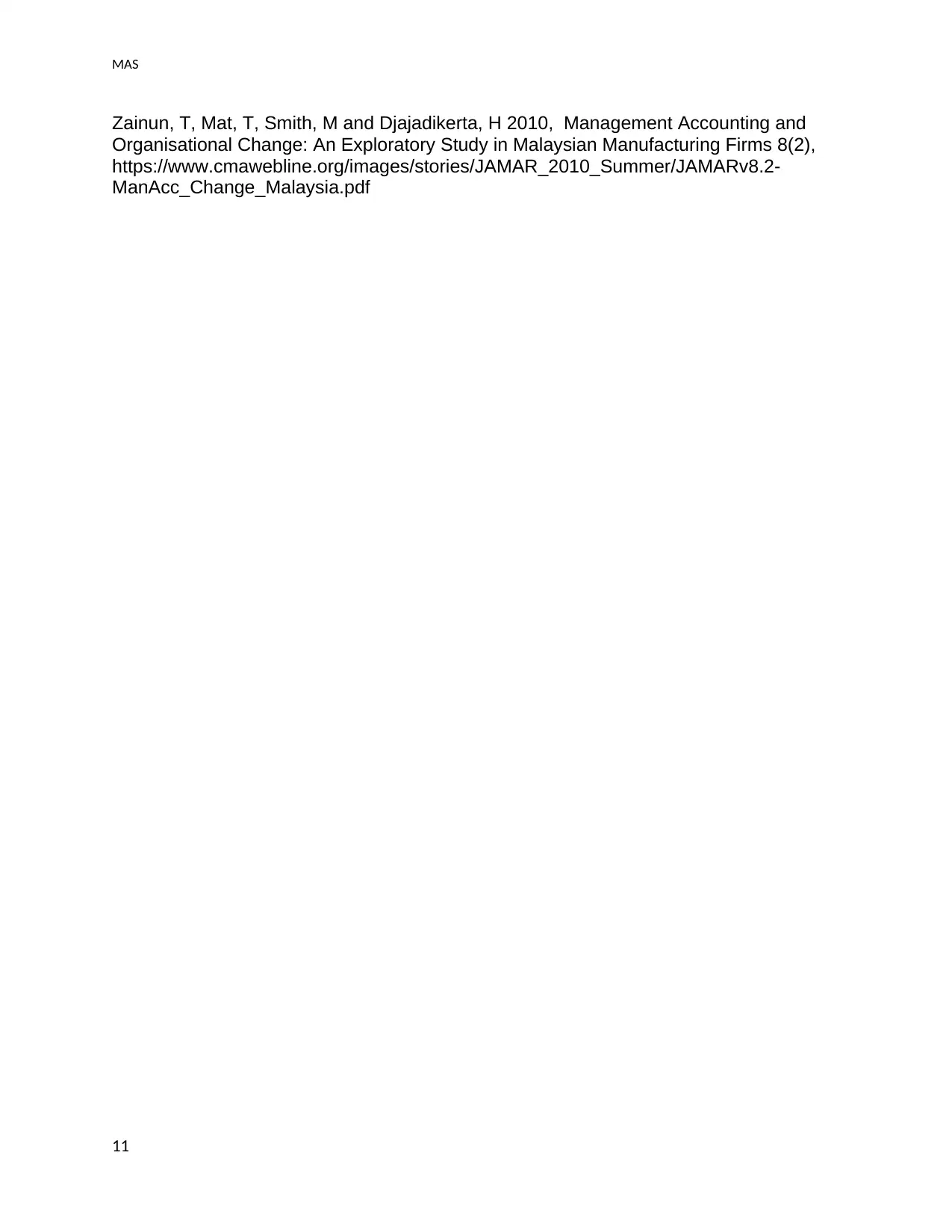
MAS
Zainun, T, Mat, T, Smith, M and Djajadikerta, H 2010, Management Accounting and
Organisational Change: An Exploratory Study in Malaysian Manufacturing Firms 8(2),
https://www.cmawebline.org/images/stories/JAMAR_2010_Summer/JAMARv8.2-
ManAcc_Change_Malaysia.pdf
11
Zainun, T, Mat, T, Smith, M and Djajadikerta, H 2010, Management Accounting and
Organisational Change: An Exploratory Study in Malaysian Manufacturing Firms 8(2),
https://www.cmawebline.org/images/stories/JAMAR_2010_Summer/JAMARv8.2-
ManAcc_Change_Malaysia.pdf
11
1 out of 11
Related Documents
Your All-in-One AI-Powered Toolkit for Academic Success.
+13062052269
info@desklib.com
Available 24*7 on WhatsApp / Email
![[object Object]](/_next/static/media/star-bottom.7253800d.svg)
Unlock your academic potential
Copyright © 2020–2025 A2Z Services. All Rights Reserved. Developed and managed by ZUCOL.





